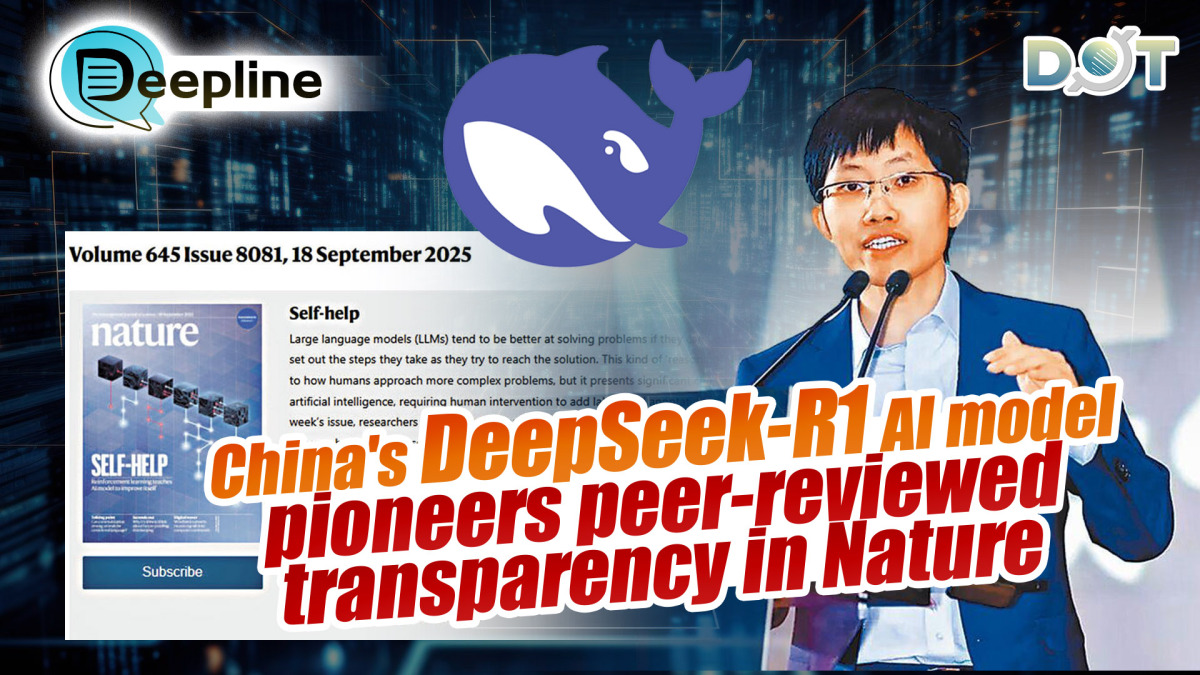
Completed by the DeepSeek team with Liang Wenfeng as the corresponding author, the research paper on the DeepSeek-R1 reasoning model was recently featured on the cover of the internationally authoritative journal Nature, making DeepSeek-R1 the world's first mainstream large language model to undergo peer review. Nature commented that relying on independent researchers for peer review is a way to counter the hype in the AI industry and hopes that more AI companies will follow DeepSeek's example.
Liu Quan, deputy chief engineer of China Center for Information Industry Development, told Wen Wei Po that DeepSeek-R1 provides a new paradigm for global AI development.
According to reports, the latest paper, which builds upon the initial paper on DeepSeek-R1 released in January this year, provides more details about the model's training. It directly addresses the distillation (model compression and knowledge transfer techniques, referring to transferring knowledge from complex models to lightweight models) discussed when the model was first released. Liang's team reported that the DeepSeek-R1 model uses reinforcement learning rather than human examples to develop reasoning steps, reducing training costs and complexity.
Innovative training methods accelerate multi-domain applications
In the paper, DeepSeek explicitly denies previous suspicions that it used OpenAI model outputs for training. In the peer-reviewed documents, DeepSeek explained that the data used for DeepSeek-V3 Base (the base model of DeepSeek-R1) is entirely sourced from the internet. While it may include results generated by GPT-4, this was not intentional, and there was no specific knowledge distillation process. To prevent benchmark data contamination, comprehensive decontamination measures were applied to both the pre-training and post-training data of DeepSeek-R1.
Additionally, the DeepSeek team publicly disclosed the training cost of R1 for the first time—only US$294,000 (approximately HK$2.286 million). Even when combined with the base model cost of about US$6 million, this amount is far lower than the costs incurred by OpenAI and Google in training their AI models.
"The official publication of the research on the universal reasoning model DeepSeek-R1, developed by a Chinese AI team led by Liang, marks a shift in AI foundational model research from technical blogs and benchmark scores to a mature discipline centered on methodological scientificity, reproducibility, and rigorous verification."
Liu stated that DeepSeek-R1 provides a new paradigm for global AI development. From a developmental perspective, it pioneers the use of reinforcement learning alone to stimulate the reasoning capabilities of large models, breaking through the limitations of previous models that relied on manual annotation, driving innovation in training methods, and accelerating applications across multiple domains.
"On the other hand, with the rapid development of AI, the public has concerns about its safety and reliability. The publication of DeepSeek-R1 after strict review, along with the disclosure of training details and responses to safety concerns, enhances transparency and credibility, laying a solid foundation of trust for the large-scale application of AI and promoting the healthy development of the industry," Liu added.
According to reports, the DeepSeek team has continuously released multiple open-source projects this year, hoping to accelerate the industry's development process. In April, DeepSeek announced that it would open-source the path of its inference engine. The industry believes that on the path of continuous open-source, DeepSeek has not only significantly advanced ecosystem building and lowered the barrier to AI applications but has also reshaped the downstream ecosystem landscape.
Open source: Knowledge sharing and technological iteration
Liu emphasized that DeepSeek's success is inseparable from the advantages of open source. The open-source model promotes knowledge sharing and technological iteration, providing a platform for innovation for global developers and pushing AI research into a new stage of science, transparency, and reproducibility. From a cost perspective, open source eliminates licensing fees and lowers the barrier to research; in terms of flexibility, developers can modify code and adjust architectures as needed; community collaboration pools global wisdom and accelerates model optimization. The advantages of open source inject strong momentum into the development of large AI models.
"The open-source strategy promotes technological democratization, points the way for the evolution of reasoning capabilities, and attracts more researchers to the industry, injecting new momentum into AI development."
Regarding the development of future industries such as artificial intelligence in China, Minister of Science and Technology Yin Hejun stated on Sept. 18 that in the field of AI, multiple domestically developed general-purpose large models have reached international advanced levels, with some models achieving accuracy rates exceeding 95%, and over a hundred benchmark application scenarios have been established.
In the field of humanoid robots, breakthroughs have been made in key technologies such as multimodal perception and brain-cerebellum models, accelerating the application of humanoid robots in scenarios such as automotive manufacturing, logistics handling, and power inspection, laying a solid foundation for the development of a future trillion-yuan industry. In the field of brain-computer interfaces, progress has been made in helping paraplegic patients stand and walk, and blind individuals regain light perception; domestically produced brain pacemakers have achieved full commercial use, with implants conducted in 400 hospitals across eight countries, becoming a new engine for high-quality development in population health.
(Source: Wen Wei Po; Journalist: Liu Ningzhe, Guo Hanlin; English Editor: Darius)
Related News:
Jensen Huang: China's AI models are 'world-class'
Thinnest iPhone ever launched: New AirPods feature real-time translation




















Comment